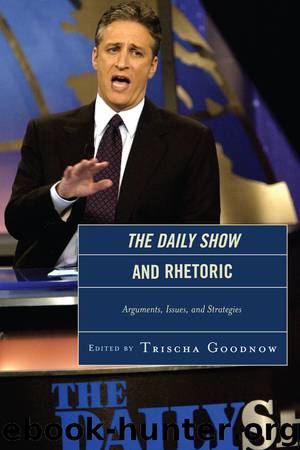The Daily Show and Rhetoric by Trischa Goodnow

Author:Trischa Goodnow
Language: eng
Format: epub
Publisher: Rowman & Littlefield Publishing Group, Inc.
III
Strategies
Chapter Eight
We Frame to Please: A Preliminary Examination of The Daily Show’s Use of Frames
Penina Wiesman
There has been a lot of buzz about Comedy Central’s satirical news program The Daily Show and its estimable host, Jon Stewart. This attention is warranted, as the program has not only won countless entertainment awards, but has also captured two Peabody awards for its coverage of the 2000 and 2004 presidential elections. In addition to Stewart’s and The Daily Show’s contribution to contemporary political discourse, research has shown that The Daily Show has become an important (though not the only) news source for the younger generation (Pew Research Center, 2004).
The Daily Show has also received significant praise from the academic world. Far from “fake,” scholars and journalists have extended their analyses to praise The Daily Show as an innovative critique of the techniques used by both politicians and the News[1] to manipulate the public (Alterman, 2009; Day, 2009; McKain, 2005), purveyor of truth (Alterman, 2009; Cornfield, 2005), a method of encouraging critical thinking (Morreale, 2009; Trier, 2008(a), 2008(b)), a facilitator of democracy (Baym, 2005; Hariman, 2007; Warner, 2007), a subversive political tool (Warner, 2007), a way to draw more people into politics and News consumption (Baym, 2005; Mutz, 2004), and even as a model for an evolved form of journalism (Baym, 2005).
Based on this nearly unbridled praise, the function of The Daily Show, in the eyes of many journalists and scholars, can be summed up with the following: The Daily Show reveals “the artificiality of real newscasts” (Day, 2009, p. 86), alerting the viewer to the highly constructed nature of News presentations of reality (by editors, media consultants and spin doctors), prompting a more skeptical consumption of these products, and possibly even political action. That The Daily Show operates as a satirical parody of mainstream television News is noted by nearly all sources. However, most are content to identify what the show is parodying before moving on to the business of proving why, based on their theoretical analysis, the program merits such praise. In other words, the discourse surrounding The Daily Show uses its parodic text as a springboard to suggest more panoptic implications of the effects of The Daily Show as a unit.
A closer examination of what exactly The Daily Show is parodying reveals a unifying element that is a characteristic of both that which The Daily Show is criticizing and the form of critique itself: framing. The aforementioned analyses of The Daily Show performed by these scholars (in particular, Baym, 2005; Day, 2009; McKain, 2005; Smolkin, 2007; and Warner, 2007) lend support to the observation that The Daily Show exposes the framing activities performed by mainstream News (and by extension, politicians, who have learned to adjust their strategy to take advantage of the News’ modus operandi (Jamieson and Waldman, 2003; Warner, 2007). As a result, it can be (and has been) argued that The Daily Show’s audiences learn to be aware of the constructed nature of packaged information from News and politicians, and are judged to be better off for it.
Download
This site does not store any files on its server. We only index and link to content provided by other sites. Please contact the content providers to delete copyright contents if any and email us, we'll remove relevant links or contents immediately.
Cecilia; Or, Memoirs of an Heiress — Volume 1 by Fanny Burney(32434)
Cecilia; Or, Memoirs of an Heiress — Volume 2 by Fanny Burney(31869)
Cecilia; Or, Memoirs of an Heiress — Volume 3 by Fanny Burney(31852)
The Great Music City by Andrea Baker(31340)
We're Going to Need More Wine by Gabrielle Union(18967)
All the Missing Girls by Megan Miranda(15565)
Pimp by Iceberg Slim(14393)
Bombshells: Glamour Girls of a Lifetime by Sullivan Steve(13972)
Talking to Strangers by Malcolm Gladwell(13222)
Norse Mythology by Gaiman Neil(13204)
Fifty Shades Freed by E L James(13157)
For the Love of Europe by Rick Steves(12945)
Mindhunter: Inside the FBI's Elite Serial Crime Unit by John E. Douglas & Mark Olshaker(9200)
Crazy Rich Asians by Kevin Kwan(9167)
The Lost Art of Listening by Michael P. Nichols(7406)
Enlightenment Now: The Case for Reason, Science, Humanism, and Progress by Steven Pinker(7228)
The Four Agreements by Don Miguel Ruiz(6630)
Bad Blood by John Carreyrou(6552)
Weapons of Math Destruction by Cathy O'Neil(6142)
